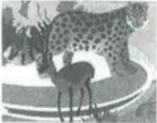China has made great achievements in biodiversity protection. Building a national park system is one of the greatest jobs that China has done so far. In October 2021, China's first five national parks were designated (认定). They are home to nearly 30% of the earth's key wildlife species (物种) found in China, covering a protected land area of 230,000 square kilometers. This table will inform you of the first five national parks—China's treasures in nature.
|
Northeast China Tiger and Leopard National Park | Locations: Heilongjiang and Jilin provinces Landscapes: Mountains, hills, and valleys Representative species: Siberian tiger, Amur leopard (豹) Progress: Increasing population of protected animal species from the year of 2015 to 2022 — Siberian tigers: 27→50; Amur leopards: 42→60 |
|
Sanjiangyuan National Park | Locations: Qinghai Province and Xizang Autonomous Region Landscapes: Glaciers, snow-capped mountains, high-altitude wetlands, deserts, alpine grasslands Representative species: Snow leopard, Tibetan antelope Progress: At present, the vegetation coverage of the grassland in the park has been over 60%, which is nearly 5% higher than that in 2015. |
|
Giant Panda National Park | Locations: Sichuan, Shaanxi and Gansu provinces Landscapes: Mountains, basins Representative species: Giant panda, red panda Progress: It is protecting over 70% of the wild giant panda population in the country. The population of protective animals in the park — Giant pandas 50+; Sichuan takins 1,300+ |
|
Wuyishan National Park | Locations: Fujian and Jiangxi provinces Landscapes: Mountains Representative species: Chinese pangolin, Cabot's tragopan Progress: Through reasonable development of 10% of its area, the park has holds its biodiversity conservation in 90% of its area under protection. |
|
Hainan Tropical Rainforest National Park | Locations: Hainan Province Landscapes: Mountains Representative species: Hainan black crested gibbon Progress: The population of Hainan's black crested gibbon in the wild — 1970s: 2 groups of 7 individuals (个体); At present: 5 groups of 36 individuals |





